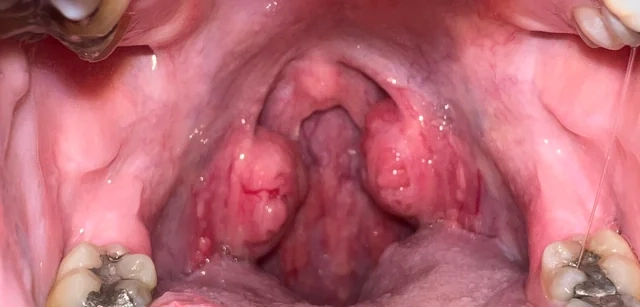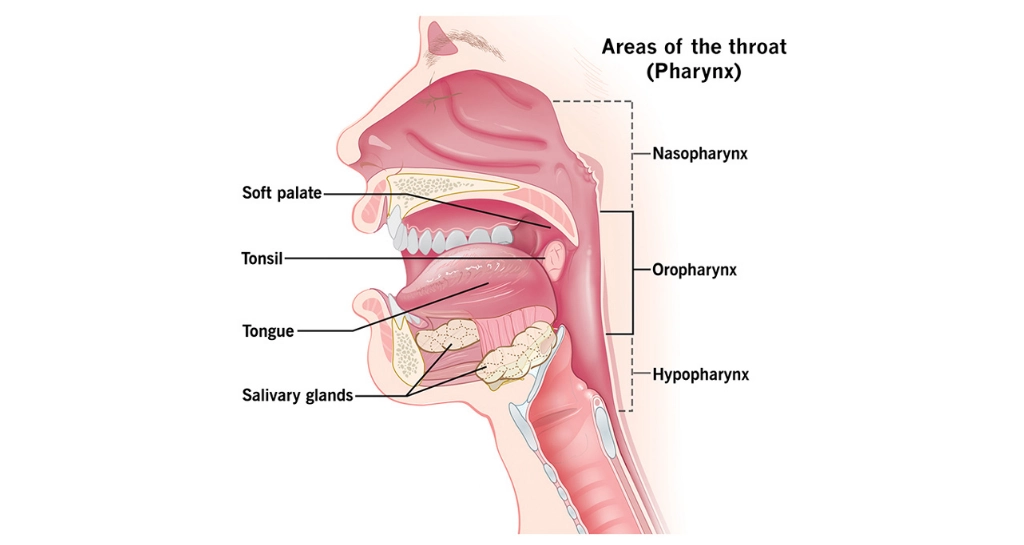What is Oropharyngeal Cancer?
Oropharyngeal cancer is a type of cancer that can originate anywhere in the oropharyndus. Depending on where it has spread, your doctor may also refer to it as tongue base cancer or tonsil cancer.
What is oropharynx?
Stretching from the soft palate to the base of the tongue, the oropharynx is a portion of the throat that is situated behind the oral cavity, or mouth.
The oropharynx’s anatomy comprises structures like the following:
Soft palate: Refers to the area behind the palate.
Uvula: The fleshy, little structure that hangs behind the soft palate.
Tonsils: The tonsils are two lymphoid tissue lumps that are situated on either side of the throat’s rear.
Base of Tongue: The area of the tongue that extends into the oropharynx from the back.
Function of Oropharynx
- The oropharynx is essential for many processes, such as breathing, speaking, and swallowing. It contributes to the immunological response as well.
- Because the tonsils are a component of the body’s lymphatic system and aid in infection prevention, they are also engaged in the immune response.
- The oropharynx is significant in medical contexts because infections and tumours frequently occur there.
- Pharyngitis, sore throat, tonsillitis, and oropharyngeal cancer are among the conditions that can affect the oropharynx.

Causes of oropharyngeal cancer
Tobacco use: One of the biggest risk factors for oropharyngeal cancer is tobacco use, which includes smoking cigarettes, cigars, pipes, and smokeless tobacco products like snuff or chewing tobacco. Tobacco smoke and products include carcinogens that can harm the cells lining the throat and cause malignant development.
Alcohol Use: Excessive alcohol use raises the risk of oropharyngeal cancer considerably, especially when paired with tobacco use. Alcohol can cause irritation and damage to the throat’s cells, increasing their vulnerability to the impacts of carcinogens.
Human Papillomavirus (HPV) Infection: HPV type 16 is one of the types of the virus that has been linked to a notable increase in oropharyngeal malignancies in recent years. Compared to non-HPV-related malignancies, oropharyngeal cancer associated with HPV usually affects younger people and has a better prognosis.
Bad Dental Hygiene: The risk of developing oropharyngeal cancer may be increased by persistent irritation and inflammation of the oral cavity and oropharynx as a result of poor dental hygiene habits. This covers things like inadequate dental care, persistent rashes from loose dentures, or persistent injuries from jagged teeth.
Symptoms of Oropharyngeal Cancer
Depending on the location and size of the tumour, oropharyngeal cancer can cause a variety of symptoms. The following are typical indications and symptoms of oropharyngeal cancer:
An ongoing, chronic sore throat that doesn’t go away on its own or get better with time or medicine.
- Dysphagia, or difficulty swallowing, is the inability or discomfort to swallow solid foods.
- Hoarseness or long-lasting changes in voice quality are examples of vocal changes.
- Unknown earache that frequently originates in the throat.
- A painless lump or mass in the neck could be a sign of metastasized cancer, which enlarges lymph nodes.
- A persistent cough does not go away on its own or get better with time or medicine.
- Weight loss
- A persistent sensation of fullness or a lump in the throat.
- Breathing difficulties or dyspnea, particularly if the tumour is obstructing the airway.
- Halitosis, or bad breath, is the term for persistent foul breath that does not go away with good dental hygiene.
- Blood-tinged saliva or phlegm could be a sign that the tumour is bleeding.
- An ongoing state of weakness or exhaustion that does not go away with rest.
It’s crucial to remember that oropharyngeal cancer is not always the cause of these symptoms, as they can also be brought on by a number of other illnesses. Nonetheless, it is imperative to visit a healthcare professional for additional assessment and diagnosis if any of these symptoms increase over time or continue to exist.
Tests for Oropharyngeal Cancer
Oropharyngeal cancer can be diagnosed and the disease’s extent can be ascertained using a number of tests and procedures. These tests assist medical professionals in assessing the tumor’s location, size, and features as well as its cancerous stage. For oropharyngeal cancer, some typical examinations and treatments include:
Physical Examination: To look for any unusual growths, tumours, or other indications of cancer, a comprehensive physical examination of the head and neck may be conducted. This examination may include a visual check of the mouth, throat, and neck.
Endoscopy: The inside of the throat, including the oropharynx, can be examined with an endoscope, which is a thin, flexible tube with a light and camera at the tip. Using a process called a laryngoscopy or pharyngoscopy, medical professionals see the tumour and remove tissue samples (biopsies) for additional examination.
Biopsy: During a biopsy, a tiny sample of tissue is taken from the oropharynx’s suspected tumour or aberrant region. A pathologist then uses a microscope to look at the tissue sample in order to identify the kind and grade of cancer as well as check for the presence of cancer cells.
Imaging Studies: To assess the cancer’s extent and ascertain whether it has spread to neighbouring tissues or other body areas, a number of imaging tests may be carried out. These could consist of:
- Computed Tomography (CT) Scan: A CT scan can identify any spread of the tumour to neighbouring lymph nodes or structures by providing precise cross-sectional images of the head and neck.
- Magnetic Resonance Imaging (MRI): An MRI scan provides information about the amount of the tumour and its relationship to surrounding structures by using radio waves and strong magnets to create detailed images of the head and neck.
Positron Emission Tomography (PET) Scan: A PET scan can assist in identifying regions of elevated metabolic activity, which may point to the existence of metastases or cancer in other body parts.
Treatment options for Oropharyngeal Cancer
The stage of the cancer, the location and size of the tumour, the patient’s preferences and general health, and other unique characteristics all influence the treatment options for oropharyngeal cancer. Combining different medicines is a common approach to treating oropharyngeal cancer. These therapies may include:
Surgery: For early-stage oropharyngeal cancer, surgery may be advised to remove the tumour and any damaged tissues. The size and location of the tumour determine how much surgery is necessary.
Radiation therapy: Targeting and eliminating cancer cells with high-energy beams. When treating oropharyngeal cancer in its early stages, it can be used alone or in conjunction with surgery for more advanced stages.Chemotherapy: Chemotherapy employs medications to either stop or destroy cancer cells. For advanced oropharyngeal cancer, it can be administered either alone or in conjunction with radiation therapy (chemoradiotherapy).

